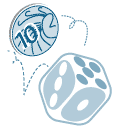![]()
Experiments and counting
We are all familiar with tossing a coin and tossing a standard die.

With a coin, the outcomes of 'head' or 'tail' are equally likely. We say that the probability of obtaining a head or a tail is \(\dfrac{1}{2}\).
With a standard die, the outcomes of 1, 2, 3, 4, 5 or 6 are equally likely and the probability of obtaining any of these is \(\dfrac{1}{6}\).
Both of these examples illustrate the point that the total probability for all outcomes for an event is 1.
Sample space
Tossing a die or a coin and recording the face that shows are both examples of an experiment.
With the coin, the outcomes are 'heads' and 'tails'; with the die, the outcomes are 1, 2, 3, 4, 5, 6. The complete set of possible outcomes for any experiment is called the sample space.
Events
An event is something that occurs, and we describe events with adjectives – for example, an event such as a sporting carnival could be described as 'memorable', 'exciting' or 'a wash-out'.
With probability and experiments, we need to define the event.
Consider the die. We are interested in getting a prime number when we toss it. In this case, the event is 'getting a prime number' and some of the outcomes will give rise to this event. For example, if the outcome is 2, the event 'getting a prime number' has occurred. We say that the outcome 2 is favourable to the event. The outcome 4 is not favourable to the event. Other terms used are success meaning favourable and failure meaning not favourable.
Example 2
Hassan tosses a die. He is hoping for a perfect square. List the sample space and the outcomes that are favourable to the event 'the result is a perfect square'.
Solution
Sample space is: 1, 2, 3, 4, 5, 6
Perfect squares: 1, 4




